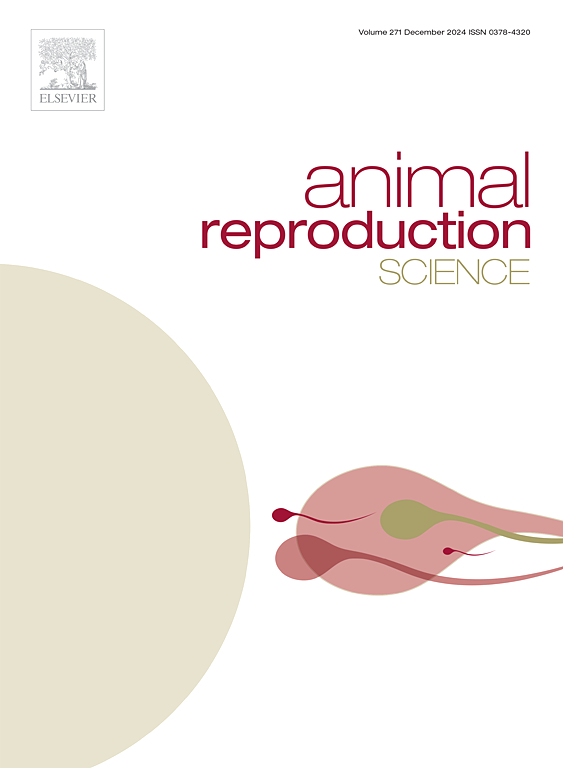叶酸通过上调谷胱甘肽和下调Fe2+积累来抑制铁突变,从而促进牛卵母细胞的体外成熟。
IF 2.2
2区 农林科学
Q1 AGRICULTURE, DAIRY & ANIMAL SCIENCE
引用次数: 0
摘要
体外受精的牛胚胎已成为全球商业胚胎移植的主要来源。然而,体外成熟(IVM)卵母细胞的发育能力大大低于体内成熟(IVO)卵母细胞,这是由于线粒体代谢产生的活性氧(ROS)在体外成熟(IVM)卵母细胞中高于体内成熟(IVO)卵母细胞。为了避免 ROS 对胚胎质量的负面影响,叶酸(FA)被直接添加到 IVM 培养基中以拮抗 ROS 的产生,但其机制仍不清楚。本研究在牛卵母细胞培养基中添加了五种浓度的叶酸(0、25、50、100 和 200 µM)。与 0 µM 组相比,50 µM 组的成熟率、裂解率和囊胚形成率分别提高了 8.95 %、6.94 % 和 4.36 %。此外,通过转录组测序,在 0 µM 组和 50 µM 组之间发现了 7904 个差异基因,它们主要富集在 8 个通路中。研究发现,卵母细胞中的谷胱甘肽、ROS 和 Fe2+ 水平与铁变态反应有关。我们的研究结果表明,50 µM FA 促进了牛卵母细胞的IVM,并影响了参与铁突变通路的基因的表达。TFR1和STEAP3的下调导致细胞内Fe2+积累减少,GCL的上调增加了卵母细胞的GSH水平,从而减少了铁嗜酸途径中ROS的产生。我们的研究为FA促进体外牛卵母细胞发育的分子机制提供了新的见解。本文章由计算机程序翻译,如有差异,请以英文原文为准。
Folic acids promote in vitro maturation of bovine oocytes by inhibition of ferroptosis via upregulated glutathione and downregulated Fe2+ accumulation
Bovine embryos by in vitro fertilization have become the primary source of commercial embryo transfers globally. However, the developmental capacity of in vitro maturation (IVM) oocytes is considerably lower than that of in vivo maturation (IVO) oocytes, owing to the production of reactive oxygen species (ROS) via mitochondrial metabolism, which was higher in IVM oocytes than in IVO oocytes. To avoid the negative effects of ROS on embryo quality, folic acid (FA) was supplemented directly into the IVM medium to antagonize ROS production, however, the mechanisms remain unknown. In the present study, five levels of FA (0, 25, 50, 100, and 200 µM) were supplemented into the bovine oocyte culture medium. The maturation, cleavage, and blastocyst formation rates increased by 8.95 %, 6.94 %, and 4.36 %, respectively, in the 50 µM group compared to the 0 µM group. Moreover, 7904 differential genes were identified between 0 µM and 50 µM groups by transcriptome sequencing, and they were mainly enriched in 8 pathways. The glutathione, ROS, and Fe2+ levels in oocytes were found to be associated with ferroptosis. Our results revealed that 50 µM FA promoted the IVM of bovine oocytes and affected the expression of genes involved in the ferroptosis pathway. The downregulation of TFR1 and STEAP3 led to a decrease in intracellular Fe2+ accumulation, and the upregulation of GCL increased oocyte GSH levels, thereby reducing the production of ROS in the ferroptosis pathway. Our study provides a new insight into the molecular mechanisms by which FA promotes bovine oocyte development in vitro.
求助全文
通过发布文献求助,成功后即可免费获取论文全文。
去求助
来源期刊

Animal Reproduction Science
农林科学-奶制品与动物科学
CiteScore
4.50
自引率
9.10%
发文量
136
审稿时长
54 days
期刊介绍:
Animal Reproduction Science publishes results from studies relating to reproduction and fertility in animals. This includes both fundamental research and applied studies, including management practices that increase our understanding of the biology and manipulation of reproduction. Manuscripts should go into depth in the mechanisms involved in the research reported, rather than a give a mere description of findings. The focus is on animals that are useful to humans including food- and fibre-producing; companion/recreational; captive; and endangered species including zoo animals, but excluding laboratory animals unless the results of the study provide new information that impacts the basic understanding of the biology or manipulation of reproduction.
The journal''s scope includes the study of reproductive physiology and endocrinology, reproductive cycles, natural and artificial control of reproduction, preservation and use of gametes and embryos, pregnancy and parturition, infertility and sterility, diagnostic and therapeutic techniques.
The Editorial Board of Animal Reproduction Science has decided not to publish papers in which there is an exclusive examination of the in vitro development of oocytes and embryos; however, there will be consideration of papers that include in vitro studies where the source of the oocytes and/or development of the embryos beyond the blastocyst stage is part of the experimental design.
 求助内容:
求助内容: 应助结果提醒方式:
应助结果提醒方式:


